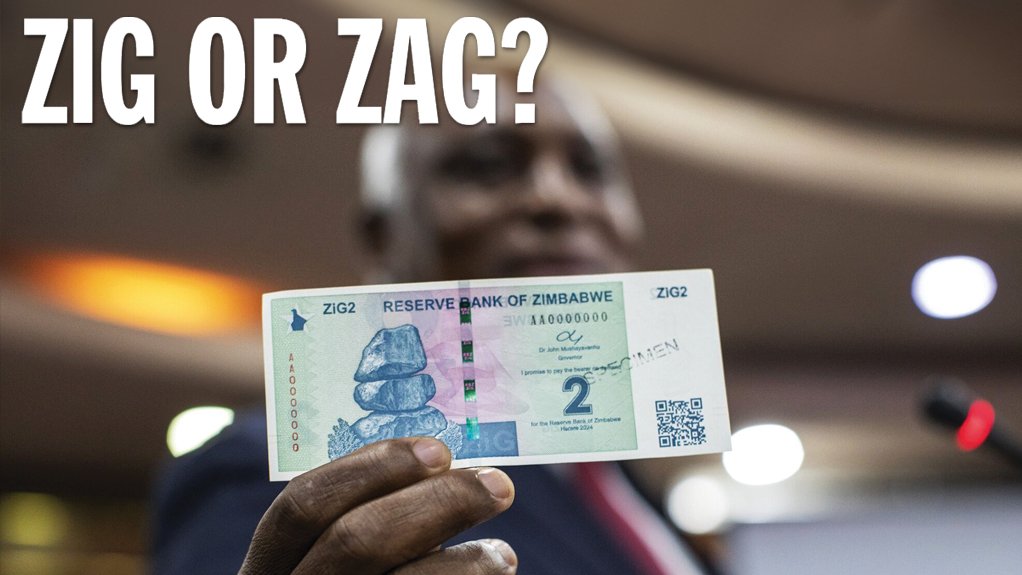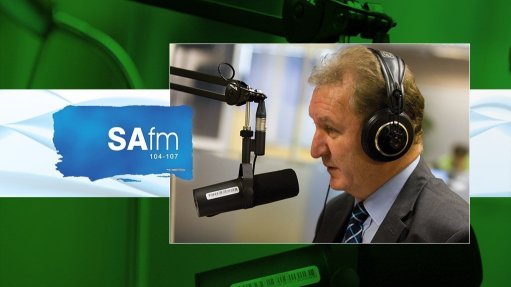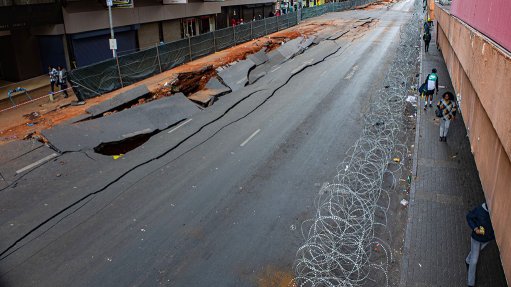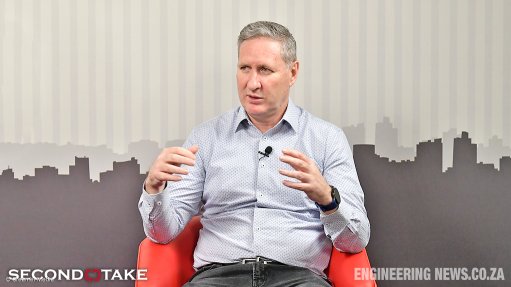Will the Zimbabwe Gold, or ZiG, restore currency confidence?
The heightened sense of urgency within Zimbabwe’s government to act as the country’s currency crashed – losing 90% of its value since the beginning of the year – was there for all to see in the past few weeks. The latest tell-tale sign was the assumption of office of the new central bank governor on March 28, a month earlier than the scheduled departure of his predecessor, to expedite the launch of a new unit.
Unveiled on April 5, the Zimbabwe Gold (ZiG) is described by the Reserve Bank of Zimbabwe (RBZ) as a “structured currency” that is backed by $285-million worth of reserve assets comprising $100-million in greenbacks, 1.1 t of gold in the bank’s vaults and an additional 1.5 t held abroad, as well as other precious minerals.
The depreciation of the ZiG’s predecessor, the Real Time Gross Settlement (RTGS) dollar, in the last few years had quickened since January. At the end of last month, a greenback would buy about 30 000 RTGS dollars at banks but the rate on the black market was 1:40 000. This coincided with inflation racing to an official year-on-year rate of 55.3%.
The ramifications for businesses and consumers alike have been dire. For businesses, this has meant having to contend with an unstable operating environment that makes planning difficult, as well as high import costs and having to implement frequent price increases in a market where consumer buying power has taken a serious knock, Harare-based economist Dr Prosper Chitambara told Engineering News & Mining Weekly from the Zimbabwean capital last week.
Attracting foreign direct investment, too, has become difficult as offshore investors typically seek stable exchange rates to mitigate their financial risk.
Zimbabwe’s currency woes are not a recent phenomenon, with Eddie Cross, an economist and former serial parastatal chief who also served as an opposition Parliamentarian from 2008 to 2018 tracing “the hoary old problem of our currency” to the first five years of independence – from 1980 to 1985. This is when the new government, keen to fulfil its liberation-war promises, invested heavily in social infrastructure and an expanding civil service. As a result, the fiscal deficit escalated from $700-million in 1980 to more than $6-billion in 1997.
Subsequently, the Zimbabwe government was forced to make an unbudgeted pay-out of Z$3.7-billion to veterans of the country’s 1970s liberation war and entered the conflict in the Democratic Republic of Congo, costing the fiscus $500-million for three years. Zimbabwe was then kicked out of the multilateral monetary system and stopped its debt repayments, rendering it unable to borrow externally.
“By 2008, we were a failed State; our currency was completely worthless,” recalls the 81-year-old, who retired from party politics in 2018 and says he now devotes his energies to contributing towards resolving the country’s challenges outside the confines of political parties.
“We then dollarised in 2009, lifted all controls – no price controls, no exchange control; a free-market economy with a vengeance,” he says, adding that this resulted in average revenue increases of 70% a year for four years and inflation tumbling from a peak of 89.7-sextillion per cent in November 2008 by renowned US economist Steve H Hanke’s reckoning to –7%, a level it retained until 2014. This period coincided with the government of national unity (GNU) that brought the incumbent Zanu-PF party and the opposition Movement for Democratic Change together, following disputed elections in 2008, and was in place until 2013.
Post the GNU, between 2014 and 2017, the central bank “printed” billions of “US dollars in electronic form”, eventually accumulating US$23-billion in local bank accounts. But, as Cross says, this was not US dollars; it was air: “In 2017 I stated that if I presented a ‘US dollar note’ to the RBZ and I was paid a real US dollar note in return, there would be an instant queue outside the bank for kilometres.”
Sure enough, in 2018 Finance Minister Mthuli Ncube separated the real US dollars from what the central bank had been printing, calling the latter RTGS dollars. Within two years, the bank balances had declined to US$3-billion, or 13% of their 2018 level. The rest, as Cross argues, was air. In other words, depositors’ bank balances were wiped out.
Worse, there was a short period when the central bank took real dollars out of bank accounts and replaced them with RTGS dollars at a 1:1 ratio. This eroded confidence in the local currency. Consequently, people “do not bank; they hold hard currency in paper form in bank security boxes and under their mattresses at home”, laments Cross.
The lack of confidence in the RTGS dollar persisted until the launch of the ZiG earlier this month, with Cross writing on his website that 85% of all deposits in the country in January were US dollars, with about US$10-billion floating around as real cash.
While Chitambara sees the ZiG as providing Zimbabwe with some respite, an opportunity to start on a new slate, he cautions that three ingredients should be in place for the hoped-for stability to endure: confidence in the currency and the central bank as the institution managing it, inflation rates that fall within an acceptable band and sufficient reserves to support the currency.
Confidence in a currency, he says, is also linked to inflation in that high rates erode the value of the currency, which causes users to lose confidence and trust in that currency, which, in turn, leads to currency substitution.
“When you look at Zimbabwe, we have been experiencing chronic high inflation, and this has weakened the local currency, resulting in a significant lack of confidence in our currency. The high inflation has been driven by unsustainable growth in money supply, which has caused the depreciation of the local currency,” says Chitambara.
He cautions that the $285-million worth of reserves that back the new ZiG currency are insufficient, explaining that they should be of such a quantum that they provide import cover for up to six months. Currently, Zimbabwe imports about $710-million worth of merchandise and services each month. “This means that we need reserves of about $4.3-billion to adequately anchor and sustain the ZiG. So, the total reserves of $285-million might not be enough.”
Chitambara also stressed the need for the Zimbabwe government to commit fully to fiscal and monetary discipline and to amend the RBZ Act in order to narrow its functions, noting that the central bank has dabbled in quasi-fiscal activities in the past.
“[Amending] the Act will also ensure that the RBZ is more independent because the risk of political interference in its operations and decision-making processes, and even that it will be forced to lend to government, remains high. Studies by both the World Bank and the International Monetary Fund have shown that countries with strong independence have been more successful in terms of reducing inflation.
“But, ultimately, the currency crisis is always symptomatic of structural and institutional challenges that are deeply embedded in the economy. What this implies is that sustainably addressing these challenges requires a comprehensive and inclusive approach that is centred on dialogue. There is also a need to address high levels of informality in the economy because [informality] weakens the effectiveness of monetary policies.”
Cross concurs that it will take more than monetary policy to put Zimbabwe’s new currency on an even keel. He points to price controls, which he decries as “killing the goose that lays the golden egg”. The RBZ, he says, has done this by forcing companies to use the so-called “auction rate” as the sole means of determining the prices on shelves, rendering companies unable to compete with a rampant informal sector that has no overheads and pays no taxes.
Questions have been asked as to whether a “structured currency” is the correct remedy for Zimbabwe. Hanke, a professor of applied economics at Johns Hopkins University in the US, who is credited with designing and implementing currency reforms that have crushed hyperinflation in several countries, is unconvinced. “I now think the only feasible solution in Zimbabwe, a country that is plagued with anomie and the inability to follow the rule of law, would be official dollarisation.
“This, actually, was successfully employed in Zimbabwe from 2009 to 2016. So, for [the country], official dollarisation has already proven itself as a solution to its inflation problems.”
Hanke also cites as success stories the dollarisation programmes of Montenegro and Ecuador. He was tasked with designing and implementing the former country’s programme in 1999 when he served as a State counsellor and adviser to the then President, Milo Dukanovic, and played a similar role in the latter country in 2001 when he was an adviser to the Finance and Economy Minister.
While the term “official dollarisation” has connotations of a country using the greenback as its legal tender – or the medium accepted for the final settlement of tax payments – official dollarisation occurs when a country eliminates its local currency and adopts the greenback or any other country’s currency as legal tender. For example, Hanke dollarised Montenegro by replacing the Yugoslav dinar with the German mark.
Moreover, while only one currency may be selected as legal tender, any currency can be used for non-tax purposes, as long as both parties are in agreement.
Had Zimbabwe opted to go the dollarisation route, Hanke says, it could have made the greenback legal tender or, alternatively, used another country’s currency, such as the South African rand. However, since the greenback is the world’s international currency and is much superior to the rand, he would not have recommended dollarising using the rand.
While Hanke would have favoured official dollarisation as the solution to Zimbabwe’s currency woes, Cross has a different take, stating in an emailed response to Engineering News & Mining Weekly: “We have to have our own currency, and we have to make it work for us. Dollarisation does not build our own capacity and employment; it destroys our comparative and competitive edge, even regionally.
“We need our own currency, and we need to re-establish confidence in it and believe that, once it goes into your pocket, it retains its value so that, when you take it out to spend, it is worth what you paid for it in sweat or kind. The only way to do that is to make it convertible . . . into a hard currency which we can use internationally.”
While Chitambara agrees that the lack of convertibility could be a challenge, he believes that, should Zimbabwe succeed in sustainably addressing inflation, confidence and convertibility would likely follow.
Cross says the RTGS dollar performed well when it was introduced in 2018, resulting in a surge in local production, a recovery in agriculture and the creation of a record number of jobs.
But, as confidence in it slipped, things started falling apart for the RTGS. As he remarked days before its replacement with the ZiG, “the RTGS dollars is dying, with the US dollar now comprising up to 90% of the economy”.
Comments
Announcements
What's On
Subscribe to improve your user experience...
Option 1 (equivalent of R125 a month):
Receive a weekly copy of Creamer Media's Engineering News & Mining Weekly magazine
(print copy for those in South Africa and e-magazine for those outside of South Africa)
Receive daily email newsletters
Access to full search results
Access archive of magazine back copies
Access to Projects in Progress
Access to ONE Research Report of your choice in PDF format
Option 2 (equivalent of R375 a month):
All benefits from Option 1
PLUS
Access to Creamer Media's Research Channel Africa for ALL Research Reports, in PDF format, on various industrial and mining sectors
including Electricity; Water; Energy Transition; Hydrogen; Roads, Rail and Ports; Coal; Gold; Platinum; Battery Metals; etc.
Already a subscriber?
Forgotten your password?
Receive weekly copy of Creamer Media's Engineering News & Mining Weekly magazine (print copy for those in South Africa and e-magazine for those outside of South Africa)
➕
Recieve daily email newsletters
➕
Access to full search results
➕
Access archive of magazine back copies
➕
Access to Projects in Progress
➕
Access to ONE Research Report of your choice in PDF format
RESEARCH CHANNEL AFRICA
R4500 (equivalent of R375 a month)
SUBSCRIBEAll benefits from Option 1
➕
Access to Creamer Media's Research Channel Africa for ALL Research Reports on various industrial and mining sectors, in PDF format, including on:
Electricity
➕
Water
➕
Energy Transition
➕
Hydrogen
➕
Roads, Rail and Ports
➕
Coal
➕
Gold
➕
Platinum
➕
Battery Metals
➕
etc.
Receive all benefits from Option 1 or Option 2 delivered to numerous people at your company
➕
Multiple User names and Passwords for simultaneous log-ins
➕
Intranet integration access to all in your organisation





















